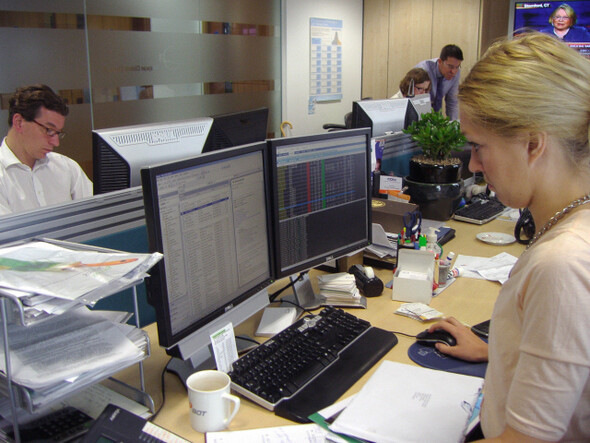hankyoreh
Links to other country sites 다른 나라 사이트 링크
Carbon credit exchange program final plan announced before Jan. 12 opening

The final plan for running the carbon credit exchange that will open in Jan. 2015 has been announced. The credit market will be open from 10 am until noon, with bids limited to a range of 10% more to 10% less of the price at the close of trading the previous day.
On Dec. 9, Korea Exchange announced that it had finalized operating regulations and other aspects of the system for the carbon credit exchange. The market will officially open on Jan. 12, 2015.
525 companies that are being allocated carbon credits will participate in the credit exchange market, along with the Korea Development Bank, the Industrial Bank of Korea, and Korea EximBank.
From 9 am, one hour before the market opens, until it closes at 12 pm, participants in the market will use a bid input program, which is similar to a home trading system (HTS), to submit bids that are -10% to +10% of the base price.
When the market lacks liquidity because there are not enough credits, the government can free up the market by borrowing credits that are held in reserve or that are scheduled to be allocated in the next period. These additional credits will be auctioned off to market players.
When trading is slack, financial authorities will have the three banks participating in the exchange submit bids to act as “market makers.”
A carbon credit exchange is a method of allowing companies to buy and sell credits corresponding to the total amount of a country’s carbon emissions. Currently, such exchanges are believed to be the most effective way to achieve goals for reducing carbon emissions.
The goal of the South Korean government is to reduce emissions to 70% of predicted greenhouse gas emissions levels for 2020, with market operations divided into three phases.
The system of credit allocation and penalties has already been adjusted after industrial interests drew attention to problems with the carbon credit market. Allocations and penalties are the key to creating an active credit market since these provide an incentive for companies to participate in the market, but these rules were relaxed under pressure from big business.
In September, the Ministry of Strategy and Finance eased its original plans by increasing the initial credit allocation to match company carbon emissions in 2013 and 2014.
The total carbon credits allocated to companies in the market correspond to 1.598 billion tons of carbon dioxide.
By Bang Jun-ho, staff reporter
Please direct questions or comments to [english@hani.co.kr]

Editorial・opinion
![[Column] Park Geun-hye déjà vu in Yoon Suk-yeol [Column] Park Geun-hye déjà vu in Yoon Suk-yeol](https://flexible.img.hani.co.kr/flexible/normal/500/300/imgdb/original/2024/0424/651713945113788.jpg) [Column] Park Geun-hye déjà vu in Yoon Suk-yeol
[Column] Park Geun-hye déjà vu in Yoon Suk-yeol![[Editorial] New weight of N. Korea’s nuclear threats makes dialogue all the more urgent [Editorial] New weight of N. Korea’s nuclear threats makes dialogue all the more urgent](https://flexible.img.hani.co.kr/flexible/normal/500/300/imgdb/original/2024/0424/7317139454662664.jpg) [Editorial] New weight of N. Korea’s nuclear threats makes dialogue all the more urgent
[Editorial] New weight of N. Korea’s nuclear threats makes dialogue all the more urgent- [Guest essay] The real reason Korea’s new right wants to dub Rhee a founding father
- [Column] ‘Choson’: Is it time we start referring to N. Korea in its own terms?
- [Editorial] Japan’s rewriting of history with Korea has gone too far
- [Column] The president’s questionable capacity for dialogue
- [Column] Are chaebol firms just pizza pies for families to divvy up as they please?
- [Column] Has Korea, too, crossed the Rubicon on China?
- [Correspondent’s column] In Japan’s alliance with US, echoes of its past alliances with UK
- [Editorial] Does Yoon think the Korean public is wrong?
Most viewed articles
- 1‘We must say no’: Seoul defense chief on Korean, USFK involvement in hypothetical Taiwan crisis
- 2N. Korean delegation’s trip to Iran shows how Pyongyang is leveraging ties with Moscow
- 3‘Weddingflation’ breaks the bank for Korean couples-to-be
- 4Korea sees more deaths than births for 52nd consecutive month in February
- 546% of cases of violence against women in Korea perpetrated by intimate partner, study finds
- 6[Column] Park Geun-hye déjà vu in Yoon Suk-yeol
- 7Will NewJeans end up collateral damage in internal feud at K-pop juggernaut Hybe?
- 8Amnesty notes ‘erosion’ of freedom of expression in Korea in annual human rights report
- 9[Editorial] New weight of N. Korea’s nuclear threats makes dialogue all the more urgent
- 10[Column] Yoon’s first 100 days should open our eyes to pitfalls of presidential system